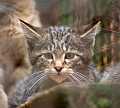Wild Cat
|
|
| Wild Cat Conservation status: Lower risk | ||||||||||||||
|---|---|---|---|---|---|---|---|---|---|---|---|---|---|---|
| Missing image European_wild_cat.jpg European Wild Cat European Wild Cat | ||||||||||||||
| Scientific classification | ||||||||||||||
| ||||||||||||||
| Binomial name | ||||||||||||||
| Felis silvestris Schreber, 1775 |
The Wild Cat (Felis silvestris) is a small predator native to Europe, the western part of Asia, and Africa. It is a hunter of small mammals, birds, and other creatures of a similar size. There are two named subspecies: the African Wild Cat or Desert Cat (Felis silvestris lybica) which remains common, and the ubiquitous Domestic Cat (Felis silvestris catus), which has been introduced to every habitable continent and most of the world's larger islands, and has become feral in many of those environments.
In its native environment, the Wild Cat is adaptable to a variety of habitat types: savanna, open forest, and steppe. Although domesticated breeds show a great variety of shapes and colours, wild individuals are medium-brown with black stripes, between 50 and 80 cm (20–32 inches) in length, and weigh between 3 and 6 kilograms (6–13 pounds). The African subspecies tends to be a little smaller and a lighter brown in colour.
European Wild Cat
The European Wild Cat (Felis silvestris silvestris) inhabits forests of Western, Central and Eastern Europe, as well as in Scotland and Turkey; it is not found in Scandinavia, Iceland, England, Wales, or Ireland. Its physical appearance is much bulkier than that of the desert cats and domestic cats. The thick fur and the size are a distinguishing mark, so that a Wild Cat normally should not be mistaken for a domestic cat.
Wild Cats were common in the European Pleistocene era; when the ice vanished, they became adapted to a life in dense forests. In contrast to domestic cats, they are active in the daytime.
Wild cats are extremely timid. They avoid coming too close to human settlements. They live solitarily and hold territories of about 3 km² each. In most European countries they have become very rare. Although being protected, they are still shot by hunters taking them for domestic cats. In Scotland, interbreeding with feral cats is also a threat to the wild population.
African Wild Cat
AfricanWildCat.jpg
The African Wild Cat or Desert Cat (Felis silvestris lybica) is distributed over deserts and savannahs of Africa and the Arabian peninsula. It is considerably smaller than the European subspecies and has shorter fur. The African Wild Cat is believed to be the ancestor of the domestic cat, since it is tamer than the European Wild Cats and active at night.
Although some authorities claim that domestication of cats took place as early as the 8000 BC, the oldest indisputable evidence is Egyptian depictions from about 4000 BC. However, a 2004 discovery in Shillourokambos, Cyprus provides strong evidence of at least the taming, if not domestication, of wild cats circa 7500 BC. [1] (http://news.bbc.co.uk/2/hi/science/nature/3611453.stm)
External links
- Felis sylvestris: (http://www.lioncrusher.com/animal.asp?animal=72) three distinct populations
- Dr. Pamela Owen, 2001, "Felis sylvestris catus" Digital Morphology (http://www.digimorph.org/specimens/Felis_sylvestris_catus/)
- Felis sylvestris gordoni: (http://www.enhg.org/b/b41/41_02.htm) first successful captive breeding, in Dubaibg:Дива котка
de:Wildkatze eo:Sovaĝa kato fr:Chat sauvage it:Felis silvestris he:חתול בר nl:Europese wilde kat no:Vollkatt pl:Żbik sl:Divja mačka

